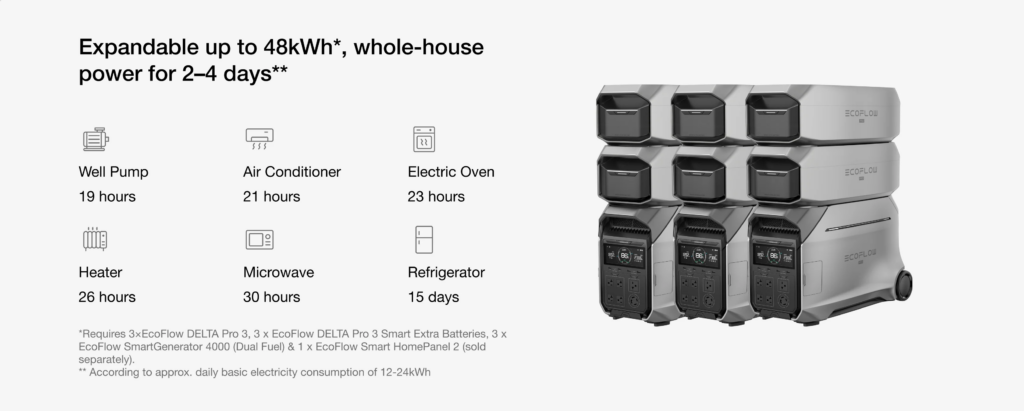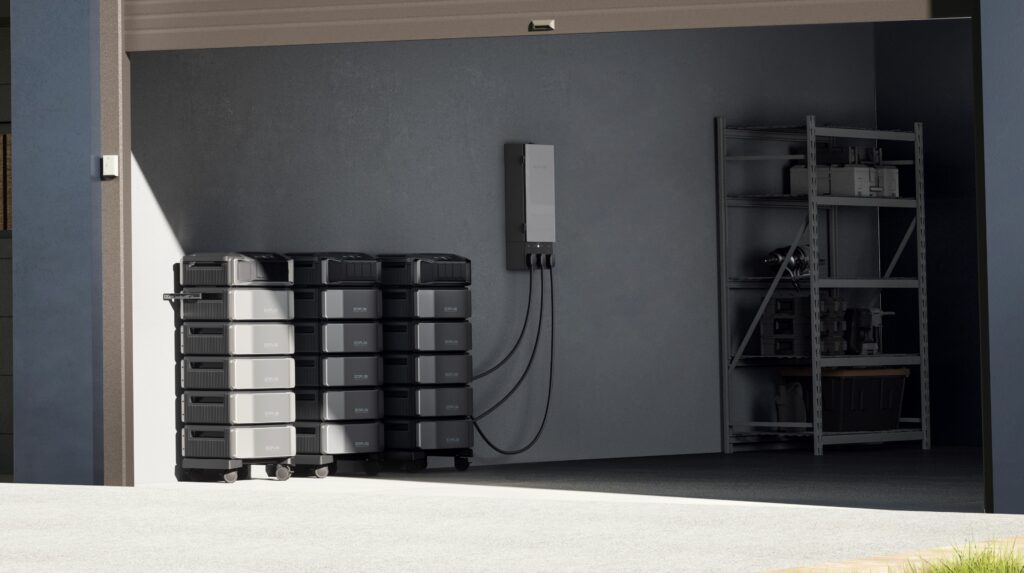Solar generators are all-in-one solutions for harnessing and storing off-grid power.
Gone are the days when you needed to run gas or diesel generators all day, creating excessive noise and pollution. Solar generators are the new standard for energy production, as they operate cleanly, quietly, and efficiently.
Solar generators can power a whole house — but how do you know which size of solar generator to purchase?
Consider your household’s electricity consumption, the frequency and duration of power outages, and other factors to determine the right solar generator size for your home.
Can a Solar Generator Run a Whole House?
Yes, a solar generator can power a whole house, but it depends on the size of the generator, the size of the house, and the household’s energy consumption. Generally speaking, a 2000-watt solar generator should be enough to cater to the needs of a typical house.
A solar generator typically includes photovoltaic solar panels, an inverter, a solar battery, and other balance of system components. Your solar generator’s power output and storage capacity largely determines what appliances you can run and for how long.
The amount of solar energy your solar panel array can capture depends on the rated power, efficiency, and number of PV panels you deploy. It also depends on environmental factors — like peak sunlight hours at your location — but solar panels can capture solar energy even on overcast days.
Depending on your household’s electricity consumption, It may be necessary to supplement your solar generator’s output and storage capacity with grid-tied power or a backup generator during periods of low sunlight or high energy usage.
Many companies offer modular solar generator systems that can run a tiny home or RV off-grid. For instance, EcoFlow Power Kits include a power hub, distribution panels, inverters, stackable solar batteries, and other components.
For larger houses, a whole home solar generator will better suit your needs.
Here are the crucial factors to consider when determining how big a solar generator must be to power your household.
How Big Should Your Solar Generator Be to Power a Whole House?
The size of a solar generator required to power a whole home depends on your family’s energy consumption.
The typical American household uses around 30 kilowatt-hours (kWh) of electricity per day, but using a ballpark figure when investing in a solar generator is never a good idea.
Determining Your Average Electricity Consumption
One way to estimate the size of the solar generator you need is to average the electricity consumption shown on your monthly electricity bills — preferably over the course of a year.
Depending on your location, your household’s electricity consumption can vary dramatically from month to month — particularly if you rely on electricity to heat or cool your home.
If your primary goal is to have a solar-powered whole home backup power solution during blackouts, you may not need to consume as much electricity as you do when the grid is available.
If that’s the case, calculating the electricity requirements of your essential appliances is a better method than looking at your average consumption.
Determining Your Essential Wattage Requirements
When deciding which solar generator, you should determine how much electricity you need. Here’s how…
- Identify the wattage requirements of your appliances. Survey the starting and running wattage requirements of the appliances and devices you plan to plug into the generator. You can usually find the wattage requirements labeled on the appliance, but we’ve also compiled the starting and running watts of typical household appliances in the table below.
- Convert volts/amps to watts. If your appliance’s power requirements are in volts or amps, you can calculate an appliance’s running watts with this equation:
Volts (V) x Amps (A) = Watts (W)
- Count the running watts of your appliances. Add up the running watts of the appliances you plan to use — does the total exceed the running watts listed on your generator? If so, consider buying a generator with more output capacity.
- Factor in starting watt requirements. Identify the appliance with the highest starting wattage. Add that appliance’s starting wattage to the running wattage total.
- Calculate the sum. That final number is the total starting watts you need from your generator. As discussed above, to avoid overloading your generator, do not exceed its starting watts rating.
Starting and Running Watts of Typical Household Appliances
| Appliance | Rated (Running) Watts | Starting Watts |
| Dishwasher | 1300 | 1800 |
| Washing Machine | 1200 | 2300 |
| Refrigerator/Freezer | 700 | 2200 |
| Light Bulb | 60-75 | 0 |
| Microwave | 600-1000 | 0 |
| TV | 500 | 0 |
| Toaster | 900 | 0 |
| Vacuum | 1440 | 2500 |
| Coffee Maker | 1000 | 0 |
| Blender | 300 | 800 |
| Clothing Iron | 1500 | 0 |
| Dryer | 5400 | 7000 |
| Toaster Oven | 1200 | 0 |
| Curling Iron | 1500 | 0 |
| Space Heater | 2000 | 0 |
| Laptop | 50-300 | 0 |
| 20” Box Fan | 200 | 350 |
A 2000W – 3000W solar generator can typically run essential home appliances. By using solar panels to recharge the generator, you can harness renewable solar energy to reliably power your home.
Here are several other things to consider when sizing a generator:
Number of People in Your Household
How many people living in your home will directly impact the system size you need. If you live alone, you can probably get away with a smaller solar generator, such as the EcoFlow DELTA Pro + 400W portable solar panel. A single EcoFlow DELTA Pro provides 3.6kWh of battery storage and up to 1,600W solar charging capacity. With four rigid 400W solar panels, the EcoFlow DELTA Pro solar generator can suffice for households of two or three people.
If you need more than 3600W of AC output (7200W surge), consider EcoFlow DELTA Pro 3.
With 4000W of AC output, EcoFlow DELTA Pro 3 can actually run up to 6000W of appliances simultaneously using proprietary X-Boost technology.

It also offers almost twice the storage expandability — up to 48kWh — so it can grow with you as your home backup needs increase.

An even more powerful option is the EcoFlow DELTA Pro Ultra, which can provide a capacity from 6kWh to an astounding 90kWh and continuous AC output from 7.2-21.6kW, allowing you to customize your power solution based on your needs. The EcoFlow DELTA Pro Ultra offers plenty of flexibility. You can add up to 42 x 400W Rigid Solar Panels to achieve 16.8kW of solar charging potential!
EcoFlow DELTA Pro 3 and DELTA Pro Ultra feature proprietary X-Core 3.0 tech architecture, providing industry-leading performance, safety, and intelligence.
X-Core 3.0 delivers the following benefits.
- X-Stream delivers record-speed charging — only 50 minutes
- X-Boost’s revolutionary soft-start algorithm supports up to 6000W of appliances and central HVAC systems with just one unit
- X-Link parallel expansion provides up to 21.6kW of output power and 90kWh of electricity storage
- X-Quiet volume minimization means whisper-quiet operation at an industry-best 30dB*
- X-Fusion outpowers the grid by providing up to 7000W of electricity output from a single AC outlet in bypass mode. Standard household plugs deliver only 1800W. Plug in EcoFlow DELTA Pro 3 or DELTA Pro Ultra and increase your output by close to 300%
- X-Guard is a protective triad of structure, material, and AI that keeps your home and family safe. It can even self-extinguish in the unlikely event of a fire.
Find out more about X-Core 3.0 here.

Electricity Consumption During a Blackout
If you keep your usage low during power outages, you can get away with a smaller generator. However, if you wish to keep your fridge and freezer running or use electricity for your HVAC system, you’ll need a solar generator with significant power output and storage capacity.
To maximize your power during an outage, try these simple tricks:
- Use LED lights or flashlights for lighting when possible.
- Keep a small supply of biodegradable disposable dishware and utensils on hand to avoid using the dishwasher and limit hot water consumption
- Instead of using an electric stovetop or oven, cook your meals on an outdoor gas grill or over a fire pit
- Keep the freezer and refrigerator closed as much as possible.
- Limit your air conditioning and heater usage
Keep in mind, you may need more or less energy throughout the day. Electricity consumption varies within a 24-hour period. Size out your system to accommodate peak energy use.
Solar Panel Array
You can have all the solar batteries in the world, but you need a correspondingly-sized solar panel array to capture the sun’s energy and keep the batteries charged.
For short-term power outages, this doesn’t matter as much. For example, EcoFlow’s solar generators offer multiple charging options — including AC (household) electricity. Keeping your solar generator fully charged between blackouts shouldn’t present much of a challenge.
But suppose you plan to reduce or eliminate your dependence on the electrical grid altogether. In that case, you’ll need to capture a substantial amount of solar power to keep your solar generator charged.
Purchasing enough solar (PV) panels to run a whole house may require a significant upfront investment. But, like all the best investments, it can pay off in the long run.
Even when grid power is available, you can save money on electricity bills by switching to your solar generator during peak hours. With a large enough solar array and generator, you can eliminate your electricity bills completely.
Blackout Frequency
How often does your region experience power outages?
If your primary goal is home power backup and you only get blackouts once or twice a year — and for only a few hours — you can probably get away with using a smaller solar generator like the EcoFlow DELTA 2.
However, if your area has been subject to prolonged blackouts from winter storms, hurricanes, or other issues, investing in a larger solar generator system makes sense.
With more power storage, output, and solar generation capacity, you can ensure your family has uninterrupted electricity access even during frequent or extended blackouts.
Can Using a Solar Generator Save You Money?
Yes, using a solar generator can save you money on your electricity bills in the long run. The initial cost of purchasing and installing a solar generator system can be substantial, but the savings from reduced energy bills can add up over time.
Additionally, the cost of solar technology is constantly decreasing, making it more affordable.
Government tax incentives and rebates can also help significantly reduce the initial costs of going solar. Depending on which manufacturer or retailer you choose, financing options are also often available.
The amount of money you can save on your utility bills over time also depends on your local electricity rates, your electricity consumption, and how much of your consumption is provided by solar.
In some regions, homeowners with grid-tied solar power systems can also sell excess energy they generate but don’t consume back to the grid. Typically, a utility company will provide excess solar energy production credits through net metering.
Net metering usually won’t put cash in your pocket, but it will offer utility credits you can use to offset on-grid electricity costs.
Conclusion
A solar generator is a wise safeguard against grid uncertainty, rising energy costs, and more frequent power outages.
With a reliable whole home solar generator, you can enjoy energy security and peace of mind.
Plus, with a wide selection of rigid, flexible, and portable solar panels, you can customize your array to maximize your solar power generation — no matter the size of your home.
Check out EcoFlow and join the solar revolution today.
*Under 2000W output
